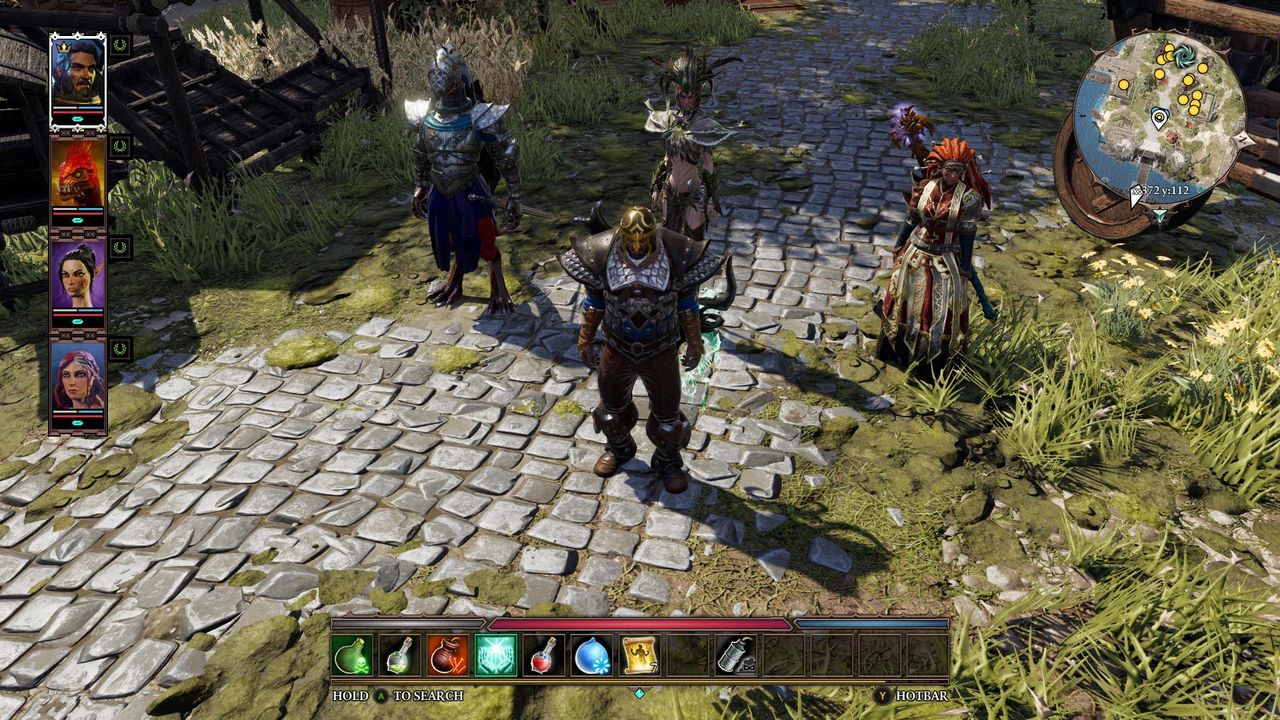Developer Larian Studios caused a sensation last year with Divinity: Original Sin 2, a game in the style of classics like Baldur’s Gate 2 and Planescape Torment which turned out to be a great sequel to the earlier Divinity: Original Sin from 2014.
As was the case with the 2014 game, Larian Studios has put out a Definitive Edition of the game for both consoles and PC (the latter of which we a reviewing here), which offers high fantasy adventure, intense tactical combat and the same isometric perspective as the classic games its based on, even if it does have a few faults of its own though.
Like the RPG classics, Divinity 2 boasts a colourful collection of characters too, and you can choose one of six characters to play as before starting a game. These are all memorable and well voice acted, and you can listen to their origin stories in the game’s character selection screen.
One of these characters is an elf rogue named Sebille, who reveals how a ruthless master forced her to kill her own kin, making her hungry for revenge. There’s also the Red Prince, a giant lizard with red skin who was to be leader of an empire, only to be kicked out of his own kingdom for “cavorting with demons”. In the end, I chose to play as Ifan Ben-Mezd, a former crusader turned mercenary who’s after the son of Lucian – the leader who betrayed him while on a campaign against the elves of Rivellon, the fantasy world where the game is set.
Watching these characters tell their origin stories sure is fun, but there are other reasons to pick one of the six named characters to play as rather than going for a custom character, picking a race and class, and choosing an appearance for your character, something which the game also allows you to do.
This is because other characters in the game world have specific dialogue for the six major characters, who have their own personal agendas which are obviously tied to their origin stories.
When in dialogue with non-player characters, you sometimes get specific responses for each of the six protagonists you can pick too, enriching your playthrough of the game. This helps build the character and sheds light on his or her motivations and ideas, adding some interesting backstory to the game.
At times though, I began to notice that I wouldn’t have missed so much if I had simply created a generic character instead of choosing warrior / crusader Ifan. After all, Ifan and any of the other characters you can pick as your avatar can join your party in the game’s first act, and since at any moment you can switch to any of these characters and still get their own unique dialogue and responses in conversations, this diminishes the sense uniqueness you get from choosing a specific character as protagonist.
It also lessens replay value, as you can switch to the likes of Sebille or the Red Prince whenever you want and control them as they were your main character too (you can only talk to your companions as the player character though).
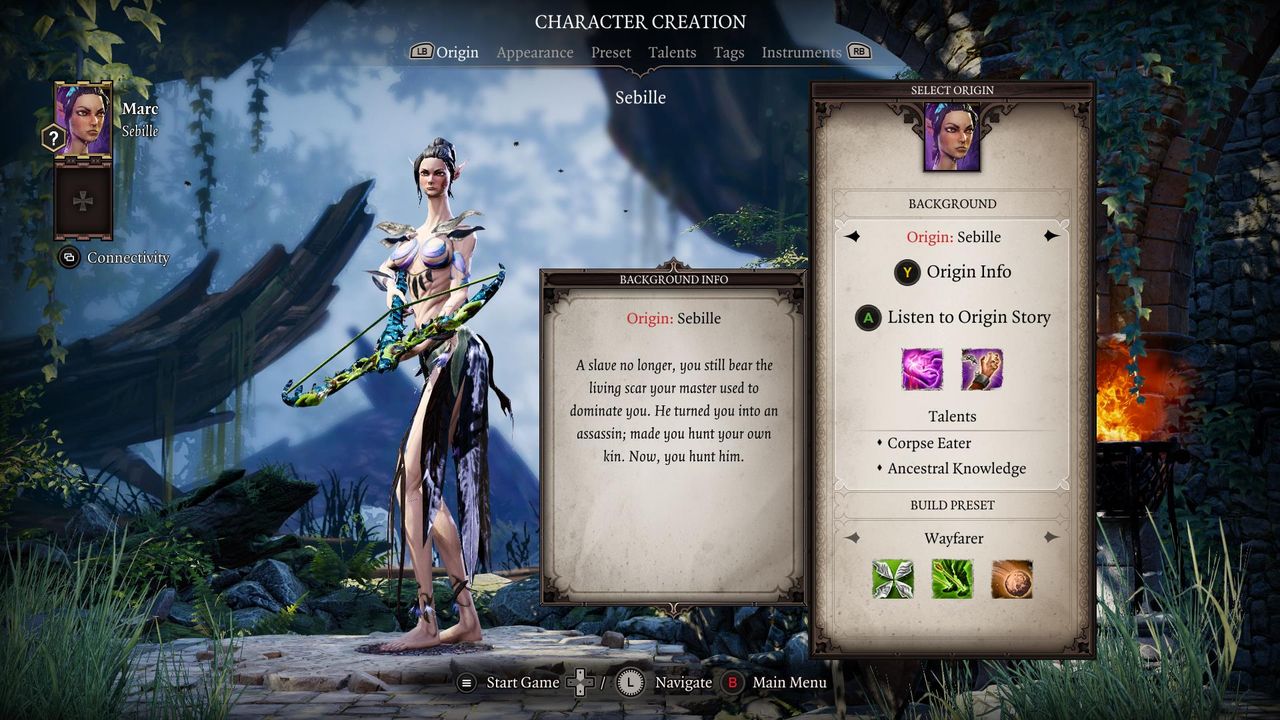
Characters like Sebille have an interesting origin story to go along with them, but you can also create your own custom character if you so wish.
But still, since your party can at most comprise four characters, you might want to play through the game again in order to pick a different party selection the next time and enjoy the storylines of any of the six main characters you may have missed on your previous playthrough.
This will also give you a chance to try the game’s various difficulty levels, and thankfully developer Larian Studios has seen fit to include a “story mode” in this definitive edition of Divinity: Original Sin 2, a good move taking into account how difficult the game is overall.
And the truth is that this suffers from the same malady as the RPG classics of yore such as Baldur’s Gate 2, meaning you’ll likely find yourself saving and reloading the game numerous times as you attempt to ace the game’s fiendishly difficult tactical battles.
Actually, one major battle early in the game’s first act had me stumped for a while – a fight against an overzealous bunch of armoured enemies, one of whom can summon a magical hound which gave me no end of trouble.
Certainly, developer Larian Studios has made a game that throws you off the deep end and expects you to learn its systems in order to survive, such as the fact characters can have two types of armour (physical and magical, each granting resistance to different kinds of attacks) and attacks of opportunity, which lets characters hit opponents as they pass by or attempt to leave their side.
This highlights the importance of positioning in battles, and I quickly learned that luring enemies out of position definitely gave my party an advantage in the game’s encounters. You can do this by separating one character from your party (the game’s user interface easily allows you to do this) and approaching an enemy group with a single character, and them retreating in order to lure them to your own party. As the old adage of war goes, it’s always better to make the enemy come to you, rather than the opposite.
The game has other tricks up its sleeve too, and it’s very gratifying to set the battlefield ablaze by placing a bunch of oil barrels and making these explode with a fireball spell, creating an inferno for your enemies to wade through… And when they get through, you might as well teleport them back to the flames by using a spell – certainly, Divinity: Original Sin 2 has no shortage of strategies to try out in combat.
In the end though, I discovered that levelling up to match opponents’ level is more important than being clever on the battlefield. The game definitely doesn’t hesitate to kick your butt if you’re not ready, which can be disheartening at times, such as on one occasion when an angry troll guarding a bridge slaughtered my entire party in one turn.
It’s a good thing then, that the game lets you examine enemies to find out their level before you attack and during battle, if only to make the decision to withdraw (which at times is possible) and come back when you are ready to face the challenge.
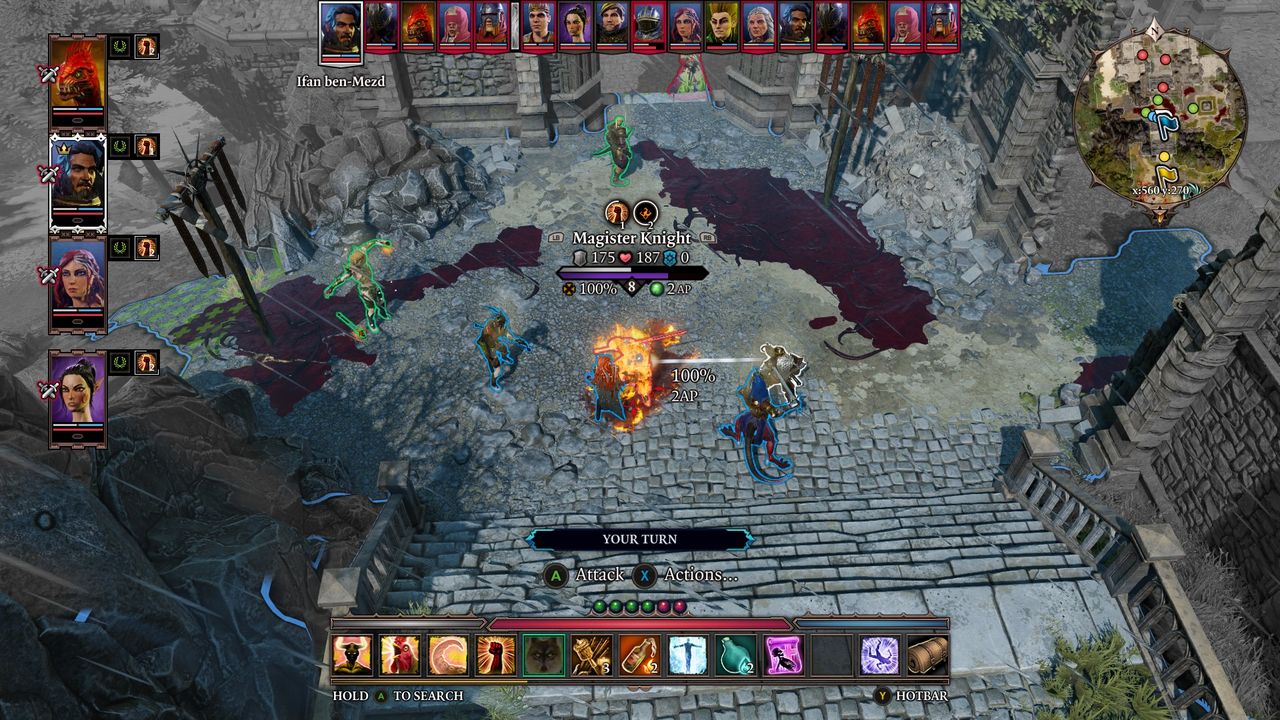
The tactical battles are not only fun to play, but also look great, even if they can be quite difficult at times though.
Even then, by-the-skin-of-your-teeth victories are common here, and I once found myself with all but one party member dead after a difficult battle with a witch character and no resurrection scrolls in my inventory (which are needed in the game to bring your dead comrades back from the dead).
This forced me to reload my game and attempt the battle again, and its clear that the save / reload cycle which afflicted so many RPGs back in the day sure is present here, and this can be frustrating at times too.
The game is just as unforgiving when it comes to certain quests, and one involving a fighting arena in the game’s first act left me stupefied when I realised I wouldn’t be able to attempt the quest again after losing the first arena battle (unless I reloaded a previous game, that is).
If it isn’t clear by this point, this is a very difficult video game overall, and only those with experience playing games of this ilk, such as the old Baldur’s Gate games or classics such as Planescape Torment, will likely be able to plough through the game in its default difficulty.
Thankfully, the previously mentioned Story Mode, which has been added to the game for this definitive edition, is more forgiving, giving your characters damage bonuses while handicapping enemies to make them easier to beat.
For instance, one particularly tough fight against a necromancer-type character on a ship suddenly becomes quite a bit easier when the guy takes less hits to defeat, and can’t summon his skeleton buddies (something he can do on Classic difficulty, the default).
However, playing on Story Mode takes away the challenge that makes the tactical battles rewarding, and is only recommended for those who simply want to enjoy the story, without stumbling from one bloody difficult battle to another, but still is a nice addition to the game.
Despite the off-putting difficulty at times though, and the fact battles are turn-based, these are not dull at all and are a blast to play through. You issue orders to each of your characters once per turn, and then enemies take their turns to attack, and it all looks great.
There are plenty of dramatic moments too, such as on one occasion when the use of a grenade which blinds enemies for several turns let me conquer what looked like an unwinnable situation at one point in a major battle.
Dramatic spell effects, as is the case of one spell which rains blood on opponents, doing damage to them, an another which allows your spellcaster to fire a bolt of lighting at an enemy, all look great onscreen, as do the various character animations for the various melee and ranged attacks, making the battles as exciting as those in an action game.
And this is a fantastic-looking game overall, no doubt. The fortresses, dungeons, forests and the beautiful statues which dot the landscape, are all rendered in fine detail, and do look superb, making this look like a believable fantasy world you may want to explore every nook and cranny of.
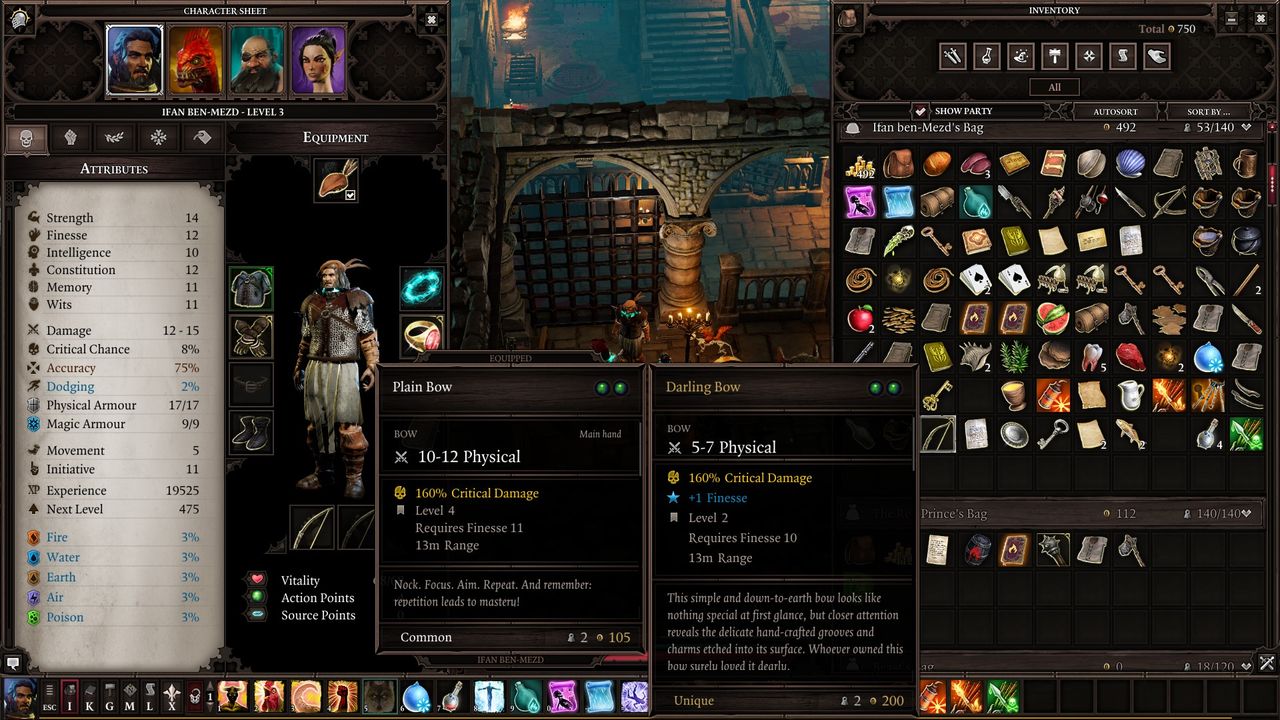
Levelling up your characters and learning the game’s systems is essential if you want to progress in this game.
Meanwhile, the music comprises the usual collection of high fantasy tunes, and while it isn’t as memorable as that of the good old classics like Baldur’s Gate, it still holds up. With some lively tunes for places such as markets and darker, more sinister themes for other locations such as dungeons, and more exciting melodies when battle kicks in, Divinity 2’s music definitely adds to the experience of playing the game.
This doesn’t mean Divinity: Original Sin 2 Definitive Edition doesn’t have its faults, and this still suffers from some of the ills of the old, classic, isometric perspective RPGs. For instance, inventory management can be a chore at times here. Each party member can carry a maximum weight (which depends on their strength attribute), although I tended to pick up most stuff with my avatar (Ifan) meaning I often found myself encumbered and unable to move.
Thankfully, the game lets you transfer gear to other party members easily, easing the burden on your main character. The thing is, as you adventure through the game’s world, loot tends to pile up, and you’ll soon find yourself visiting a merchant to sell unused wares, or taking your time to decide which items to discard – something which can become a chore after a while.
Divinity 2 does have a ton of gear for you to acquire, and those who enjoy exploring the world in order to find the best weapons, spells and armour have all their bases covered here. The game also easily lets you compare items of the same type (two single-handed weapons for instance) to decide which one you want to equip a character with – something which can keep you busy for quite some time.
You can see how armour, robes or other clothing looks on your characters in the equipment screen too – if anything Divinity 2 caters for the vainglorious too, letting your characters hit hard on the battlefield while looking good too.
I also appreciated the fact that this doesn’t throw reams of text at the player like other recent games in the Baldur’s Gate 2 mould have done (I’m looking at you, Pillars of Eternity), so you won’t have to wade through a novel’s worth of text to enjoy the story here, even if there’s still quite a bit of text to read at times truth be told. Plus, all the dialogue is voiced too, adding to the feeling of immersion. The voice acting is pretty good as well, and some characters like Sebille and The Red Prince sure are outstanding.
There are however, some inconsistencies in the dialogue, and it’s sometimes jarring to hear a character tell you that your next goal should be to locate a certain other character, whom you’re standing right next to.
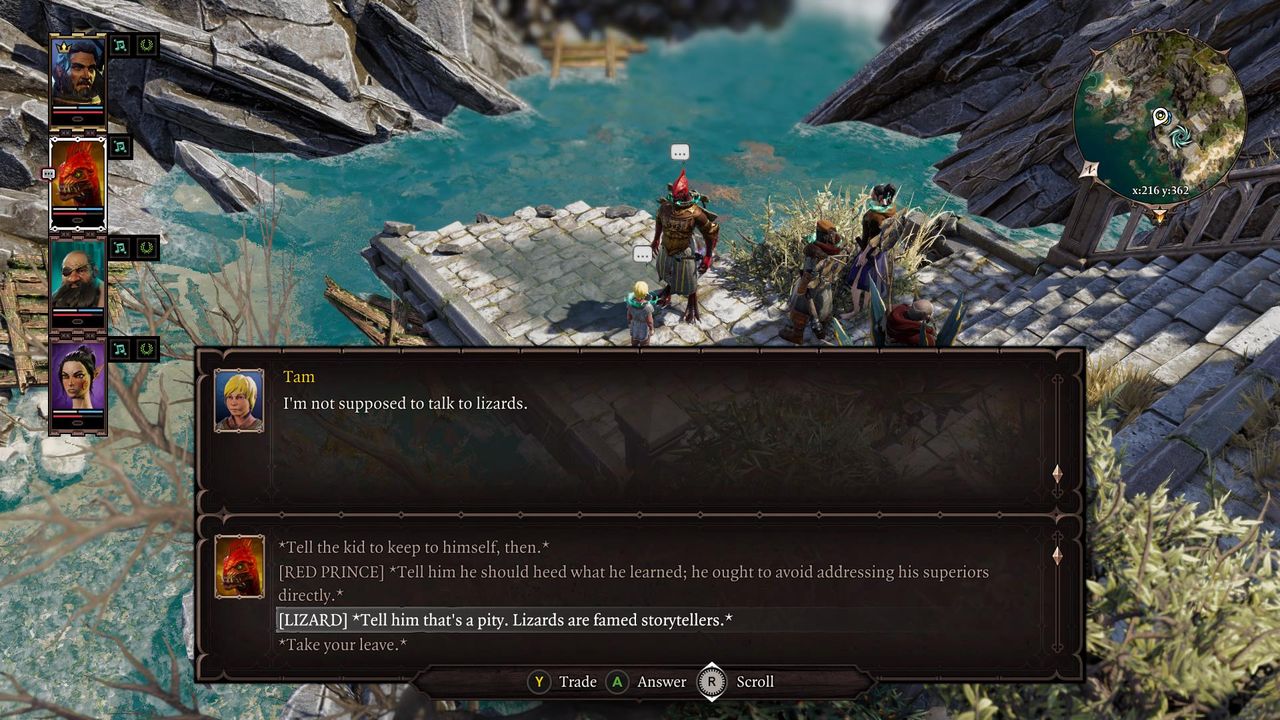
There’s plenty of funny and interesting dialogue to enjoy in this definitive edition of Divinity: Original Sin 2.
Also, I was surprised to discover this actually plays better with gamepad than mouse and keyboard, which is the way I have enjoyed these kind of games over the years, but thankfully the gamepad interface is really good and scales well all the way up to 4K resolution. Larian Studios obviously put a lot of work into this, especially taking into account this definitive edition of Divinity: Original Sin 2 hit consoles as well as PC this summer.
So, what to make of Divinity: Original Sin 2 Definitive Edition?
This game clearly is not for everyone, and the difficulty can be off-putting at times, truth be told. Nonetheless, if you want a hard, drawn out RPG in the classic mould and are ready to invest a lot of time in it (the opening act alone can devour dozens of hours of your time), you’ll be rewarded in the end, and it sure can be very gratifying when you finally win a battle which seemed impossible before, making this one of the best role-playing games to be released in a very long time and one that’s even better now thanks to this definitive edition.
Divinity: Original Sin 2 Definitive Edition
Score: 91 / 100
Available on: PS4 | Xbox One | PC
Reviewed on: PC (System: Intel Core i5-8400, 16 GB of RAM, Nvidia GTX 970, SSD Drive)
Publisher: Larian Studios
Launch date: August 31, 2018
This game was reviewed using a copy purchased for the purpose of this review.

